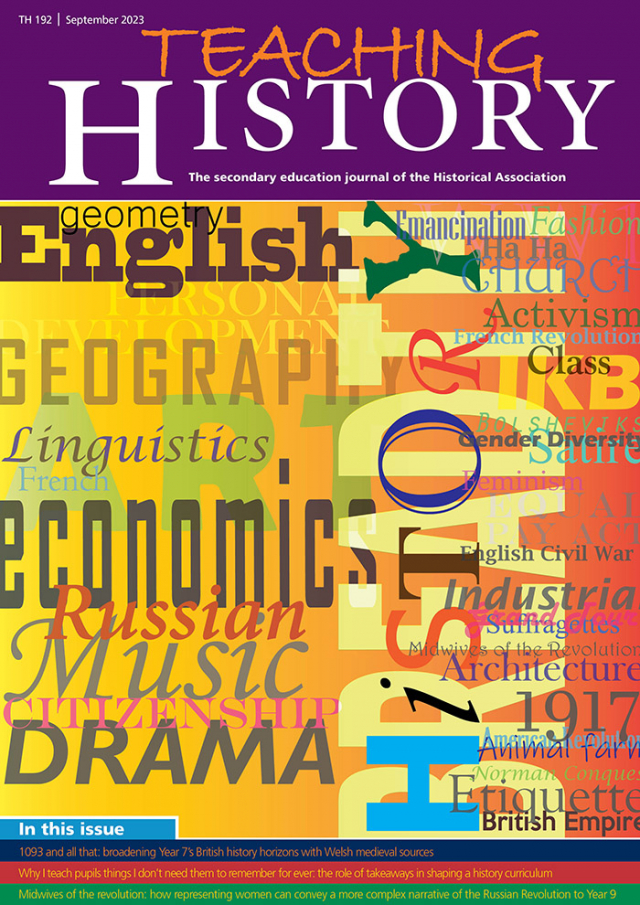Teaching History 192: Out now
The HA's journal for secondary history teachers

Editorial: Breadth
Read Teaching History 192: Breadth
If the length of a curriculum relates to how long it lasts – to its duration in classroom time and to the volume of historical time it covers – then curricular breadth refers us to the number and the variety of the dimensions of human past that a curriculum explores. Broad history ranges widely, in time and geography and theme, like Braudel’s Civilisation and Capitalism, Diamond’s Guns, Germs and Steel, or Frankopan’s Silk Roads.1 What might it mean to broaden the history curriculum in historically and educationally valuable ways? All of this month’s authors engage with these issues to one degree or another and in one way or another.
Holly Hiscox argues for breadth as a way of ensuring better understanding of the complexity of the past, a claim she develops by reporting an enquiry into the Norman Conquest of Wales. Hiscox’s enquiry broadens the curriculum, by exploring Welsh content and, also, through the kinds of sources her students work with, including folkloric and mythic stories. Hiscox points to implications in the present – to a better understanding of the cultural complexity of Great Britain.
Jonathan Grande poses an intriguing question – why we might want students to learn things that they are ultimately going to forget. Reflecting on experiences of knowledge-building, Grande argues that providing multiple examples of particulars can build-up and secure the general representations of the past that we want children to learn. Breadth can have a further particular value, then: teaching a wider range of knowledge than children ultimately need can be vital in ensuring they learn what they need to know securely and effectively.
Trapani became troubled by easy generalisations her students were making – generalisations that simplified the past, narrowing its complexity and confining its rich diversity within simple judgments – and by the sweeping connections they made to their English lessons when studying the Russian Revolution. Using women’s history as a case study, Trapani explores how a focus on a broad range of experiences in the past can help students’ judgements become more mature and enhance their understanding of the challenges historians face when explaining past complexities.
As ardent advocates of eighteenth-century history, Rhian Fender and Steven Ragdale were determined to ensure that the period found a secure place within their department’s Key Stage 3 curriculum. Given the extraordinary range of contrasts that epitomise the long eighteenth century, and only ten lessons within which to explore them, Fender and Ragdale here present a fascinating account of their curricular decision-making, showing how they combined an emphasis on breadth with a strong focus on material culture, to create a sense of (the whole) period that was both visual and physical.
Geraint Brown and Matthew Stanford share the daunting challenge and intriguing opportunities that are presented by leading a school history trip to a site as complex as Berlin. That the city is a palimpsest, layered with stories and interwoven with conflicting identities, experiences and meanings, makes planning a trip extremely difficult. At the same time, these layers give opportunity to understand a site as a contested historical space, to learn more of how accounts and interpretations of the past are constructed, and to examine what they mean to diverse audiences.
Rather than thinking just about the breadth of the history that we choose to teach Vicky Bettney and Nicole Ridley ask us to think broadly about the context in which that teaching happens and in which our students learn. They ask us to think about history in the context of the whole school curriculum and in relation to education about personal development. They explore how the history curriculum and the personal development curriculum can work together, to reinforce knowledge building and to help students connect up and apply their learning. In short, they ask us to think of teaching and learning history in a broader context than just the history curriculum.
References
1 Braudel, F. (1984) Civilization and Capitalism, 15th–18th Century, 3 volumes, London and New York: HarperCollins; Diamond, J. (1998) Guns, Germs and Steel: a short history of everybody for the last 13,000 years, London: Vintage; Frankopan, P. (2016) The Silk Roads: a new history of the world, London and New York: Bloomsbury.

